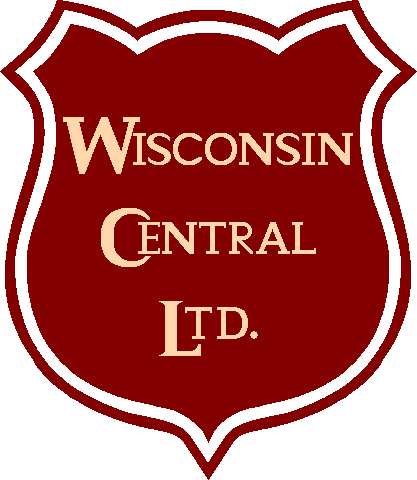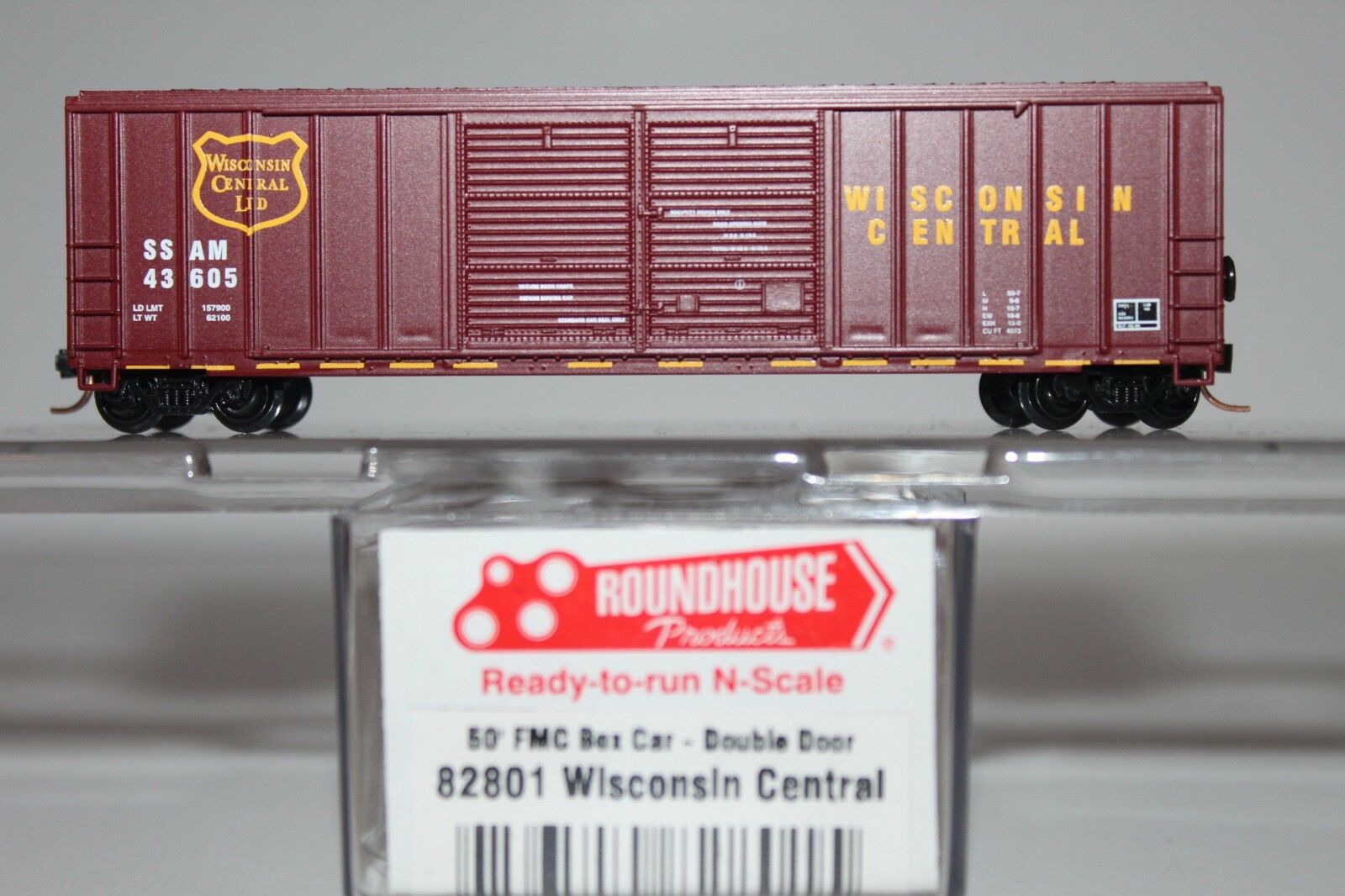Model Information: Boxcar, 50 Foot, Double Sliding Door, Rib Side, Without Roofwalk, FMC. This body style was acquired by Athearn from MDC Roundhouse in June of 2004.
Prototype History: In the 1970's with the growth of the Per Diem business model, FMC produced a series of 50 foot box cars in different configurations. The single-sliding-door configuration is one of the best known and used widely by many different railroads. These cars were produced using the Gunderson metal works which FMC had acquired in 1965. In late 1975, FMC began producing a 5,077-cubic-foot Plate B box car for IPD and Railbox service. FMC's 5077s have seven panels to either side of the 10-foot door, an X-panel roof, and non-terminating ends that are slightly different from those used on FMC's earlier cars. Note how the sidesill is notched all the way back to the bolsters, a key feature of FMC's mature design.
The main difference between the 5077 cu. ft cars built by FMC vs the 5277-5347 cu. ft cars built by the same manufacturers is the overall height of the car, the smaller 5077 cars were Plate B while the larger 5277-5347 cars were Plate C. Over 4,300 cars were produced from 1975-1979 by FMC's Portland, Oregon plant. The cars were delivered in numerous colorful shortline paint schemes, as well as the nationwide car pool fleet of Railbox. Many secondhand cars were later seen in Class 1 railroads and large leasing company fleets under additional shortline reporting marks.
The main difference between the 5077 cu. ft cars built by FMC vs the 5277-5347 cu. ft cars built by the same manufacturers is the overall height of the car, the smaller 5077 cars were Plate B while the larger 5277-5347 cars were Plate C. Over 4,300 cars were produced from 1975-1979 by FMC's Portland, Oregon plant. The cars were delivered in numerous colorful shortline paint schemes, as well as the nationwide car pool fleet of Railbox. Many secondhand cars were later seen in Class 1 railroads and large leasing company fleets under additional shortline reporting marks.
Road Name History:  Wisconsin Central Ltd. (reporting mark WC) is a railroad subsidiary of the Canadian National Railway. At one time, its parent Wisconsin Central Transportation Corporation owned or operated railroads in the United States, Canada (Algoma Central Railway), the United Kingdom (English Welsh & Scottish), New Zealand (Tranz Rail), and Australia (Australian Transport Network).
Wisconsin Central Ltd. (reporting mark WC) is a railroad subsidiary of the Canadian National Railway. At one time, its parent Wisconsin Central Transportation Corporation owned or operated railroads in the United States, Canada (Algoma Central Railway), the United Kingdom (English Welsh & Scottish), New Zealand (Tranz Rail), and Australia (Australian Transport Network).
Wisconsin Central Ltd. (WC) started in US in the mid-1980s using most of the original Wisconsin Central Railway's rights of way and some former Milwaukee Road rights of way after the Soo Line Railroad acquired the Wisconsin, Illinois, Indiana, Missouri and Minnesota holdings of the bankrupt Milwaukee Road and divested its older railway trackage in Wisconsin. In 1993 the Wisconsin Central also acquired the Green Bay and Western Railroad and the Fox River Valley Railroad.
At the time of its sale to Canadian National, Wisconsin Central operated over 2,850 miles (4,590 km) of track in the Great Lakes region. The railroad extended from Chicago into and through Wisconsin to Minneapolis/St. Paul and Duluth, Minnesota, to Sault Ste Marie, Michigan, and north (through the Algoma Central Railway) to Hearst, Ontario.
A condition of Soo Line’s acquisition of Milwaukee Road was that they had to sell a number of lines in Wisconsin and Michigan’s Upper Peninsula. They established Lake States Transportation to separate these lines from the rest of Soo Line. In 1987, Lake States was sold to a group of investors and Wisconsin Central was born. Much of the track had belonged to the original Wisconsin Central, a Soo subsidiary which had been merged into Soo in 1960. In 1993, WC acquired Fox River Valley Railroad and Green Bay & Western. In 1995, they founded a Canadian subsidiary and acquired the Algoma Central. Then in 1997, they picked up another 200 miles of former C&NW line running north from Green Bay from Union Pacific. At this point, the 2,850 mile WC (between GM&O and Erie Lackawanna in relative size) linked: Chicago, Milwaukee, Green Bay, Minneapolis/St.Paul, Duluth/Superior, then down Michigan’s Upper Peninsula to Sault Ste. Marie where they connected to Algoma Central north to Hearst, Ontario. WC’s parent company also went on a buying spree of railroads in other countries including New Zealand, Britain, and Australia. Wisconsin Central was sold to Canadian National in 2001. It operates as a paper railroad under CN’s flag today.
From Wikipedia and Bluford Shops

Wisconsin Central Ltd. (WC) started in US in the mid-1980s using most of the original Wisconsin Central Railway's rights of way and some former Milwaukee Road rights of way after the Soo Line Railroad acquired the Wisconsin, Illinois, Indiana, Missouri and Minnesota holdings of the bankrupt Milwaukee Road and divested its older railway trackage in Wisconsin. In 1993 the Wisconsin Central also acquired the Green Bay and Western Railroad and the Fox River Valley Railroad.
At the time of its sale to Canadian National, Wisconsin Central operated over 2,850 miles (4,590 km) of track in the Great Lakes region. The railroad extended from Chicago into and through Wisconsin to Minneapolis/St. Paul and Duluth, Minnesota, to Sault Ste Marie, Michigan, and north (through the Algoma Central Railway) to Hearst, Ontario.
A condition of Soo Line’s acquisition of Milwaukee Road was that they had to sell a number of lines in Wisconsin and Michigan’s Upper Peninsula. They established Lake States Transportation to separate these lines from the rest of Soo Line. In 1987, Lake States was sold to a group of investors and Wisconsin Central was born. Much of the track had belonged to the original Wisconsin Central, a Soo subsidiary which had been merged into Soo in 1960. In 1993, WC acquired Fox River Valley Railroad and Green Bay & Western. In 1995, they founded a Canadian subsidiary and acquired the Algoma Central. Then in 1997, they picked up another 200 miles of former C&NW line running north from Green Bay from Union Pacific. At this point, the 2,850 mile WC (between GM&O and Erie Lackawanna in relative size) linked: Chicago, Milwaukee, Green Bay, Minneapolis/St.Paul, Duluth/Superior, then down Michigan’s Upper Peninsula to Sault Ste. Marie where they connected to Algoma Central north to Hearst, Ontario. WC’s parent company also went on a buying spree of railroads in other countries including New Zealand, Britain, and Australia. Wisconsin Central was sold to Canadian National in 2001. It operates as a paper railroad under CN’s flag today.
From Wikipedia and Bluford Shops
Brand/Importer Information:  MDC Roundhouse was founded in California in 1938 and relocated in 1993 to Carson City, Nevada due to statewide restrictions on painting. MDC Roundhouse was a producer of both RTR (Ready-to-Run) and kit versions of N Scale rolling stock as well as RTR locomotives. They entered the N scale market in 1979 with a Thrall Hi-Side Gondola and a Hi-Cube Single Door Box Car. MDC Roundhouse was purchased by Horizon Hobbies in June of 2004, when its owner since 1938 C. H. Menteer retired, and merged into their Athearn line.
MDC Roundhouse was founded in California in 1938 and relocated in 1993 to Carson City, Nevada due to statewide restrictions on painting. MDC Roundhouse was a producer of both RTR (Ready-to-Run) and kit versions of N Scale rolling stock as well as RTR locomotives. They entered the N scale market in 1979 with a Thrall Hi-Side Gondola and a Hi-Cube Single Door Box Car. MDC Roundhouse was purchased by Horizon Hobbies in June of 2004, when its owner since 1938 C. H. Menteer retired, and merged into their Athearn line.
Unlike many of their contemporaries which contracted with European firms to produce their products, MDC made their own toolings. They made several popular body styles and produced them for road names that many other vendors (even Micro-Trains) wouldn't touch. This made them popular with modelers. Also, their un-assembled "kits" permitted a lower price point so they were popular with "runners" as well as "modelers".
Of particular interest was the attention given to modern 50 foot steel boxcars. They made some attempt to accurately mold the differences into distinct models to represent each of the major prototype manufacturers products. They have distinct toolings not only for the different products from FMC, BFF and PS, but also multiple models for each of these manufacturers including "standard" vs "Youngstown" doors and "waffle" vs. "rib" sides. In total they produced 13 different versions of the 50 foot steel boxcar.

Unlike many of their contemporaries which contracted with European firms to produce their products, MDC made their own toolings. They made several popular body styles and produced them for road names that many other vendors (even Micro-Trains) wouldn't touch. This made them popular with modelers. Also, their un-assembled "kits" permitted a lower price point so they were popular with "runners" as well as "modelers".
Of particular interest was the attention given to modern 50 foot steel boxcars. They made some attempt to accurately mold the differences into distinct models to represent each of the major prototype manufacturers products. They have distinct toolings not only for the different products from FMC, BFF and PS, but also multiple models for each of these manufacturers including "standard" vs "Youngstown" doors and "waffle" vs. "rib" sides. In total they produced 13 different versions of the 50 foot steel boxcar.
Item created by: gdm on 2018-12-17 16:40:30
If you see errors or missing data in this entry, please feel free to log in and edit it. Anyone with a Gmail account can log in instantly.
If you see errors or missing data in this entry, please feel free to log in and edit it. Anyone with a Gmail account can log in instantly.









